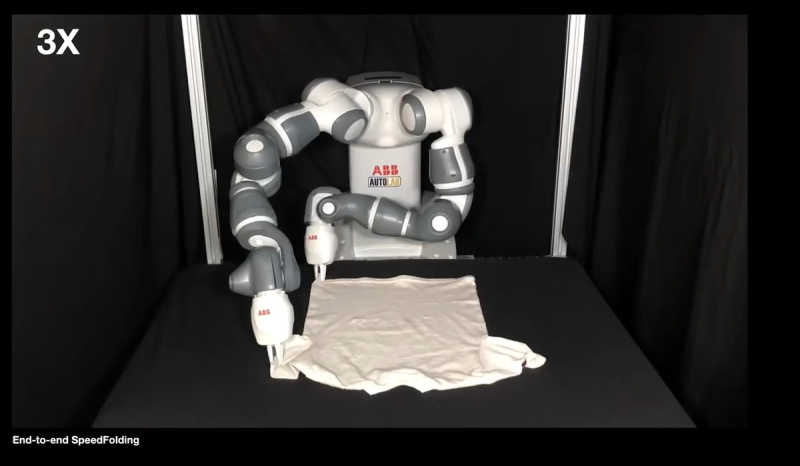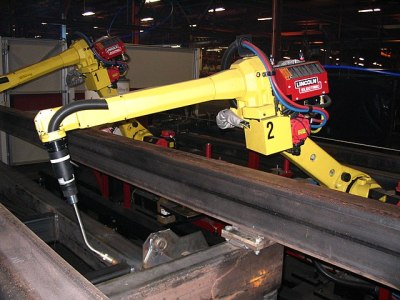

Robots Are Folding Laundry, But They Suck At It
source link: https://hackaday.com/2022/10/26/robots-are-folding-laundry-but-they-suck-at-it/
Go to the source link to view the article. You can view the picture content, updated content and better typesetting reading experience. If the link is broken, please click the button below to view the snapshot at that time.
Robots Are Folding Laundry, But They Suck At It

Robots are used in all sorts of industries on a wide variety of tasks. Typically, it’s because they’re far faster, more accurate, and more capable than we are. Expert humans could not compete with the consistent, speedy output of a robotic welder on an automotive production line, nor could they as delicately coat the chocolate on the back of a KitKat.
However, there are some tasks in which humans still have the edge. Those include driving, witty repartee, and yes, folding laundry. That’s not to say the robots aren’t trying, though, so let’s take a look at the state of the art.
The Challenges of Folding At Home

Robots are great at jobs with simple, repetitive motions.
They’re less good at jobs where they have to figure out what the right moves are. Credit: Phasmatisnox, CC-BY-SA-3.0
Laundry automation was a game changer for home life when it first hit the mainstream. The washboard and the mangle gave way to the automatic washing machine and the clothes dryer, and the busy working people of the world rejoiced. No longer would they toil for hours just to get some clean clothes!
However, the next step in the process, folding, has not seen mainstream automation just yet. This is largely due to the fact that folding laundry is simply a much more complicated task than washing or drying. Those tasks simply involve chucking a bunch of clothes into a tub, and shaking them about with either water and soap or heat applied. It’s a batch process whose primary control input is the RPM of a single motor.
Folding first requires a single piece of laundry to be separated from the pack and identified. Machine vision has come a long way in the last decade, but this is still a challenging task. Plus, clothes can become entangled with others in a pile, further complicating the issue for a hypothetical robot folder. Towels, socks, skirts, and jeans are all different, and require their own techniques to deal with. Fancy clothes with straps and buckles and unique structures only add further challenges.
State of the Art
Researchers from UC Berkeley and the Karlsruhe Institute of Technology have developed a robot capable of folding laundry so quickly that they’ve termed the process “SpeedFolding.” It uses a robot with two “hands” which work together to fold clothes, much like we do. As per the research paper, the team claims the robot can fold 30-40 garments in an hour. That’s pretty much an order of magnitude faster than previous robotic folding efforts, which achieved fold times more on the order of 3-6 garments folded per hour.
The robot begins by scanning the laundry item to be folded with an overhead camera. It then uses a neural network trained on 4,300 different actions to identify how to get the randomly-aligned garment into the necessary initial state for folding. Various motions are used by the robot to achieve this, including moving the garment or parts of the garment around, flinging it around, or dragging it along a surface.
The neural network was trained in a variety of ways, with the primary smoothing step a key part of the process. The robot was allowed to perform different actions autonomously with the set goal of maximising the garment’s surface area. This was a useful way to teach the robot to get the garment into a controlled initial state for folding. Once the garment is in such a state, prescribed actions can be executed to complete the folding process. Useful techniques from the human world are applicable to the robot, too. The classic “2-second fold” that can be used on T-shirts is used by the robot to fold an already-flat tee in under 30 seconds. However, the general process takes longer than that. The full procedure of garment identification, state initialization, and then folding takes about two minutes on average.

The SpeedFolding setup uses a twin-arm ABB Yumi robot to fold clothes. It can fold randomly-aligned clothes at a rate of approximately 30-40 garments per hour. Credit: Youtube, Griffig
As it stands, though, the technology is still very much at the demo stage. The twin-armed robot used is an advanced device costing tens of thousands of dollars, and the industrial 3D vision system likely doesn’t come cheap either. Plus, it’s not mobile, so can only work in a small space in front of its base.
The folding results obviously aren’t up to human speeds, but they also leave something to be desired in quality, too. The pincer manipulators are capable of picking up many different articles of clothing, but they lack finesse. The garments folded by the robot aren’t particularly neat and tidy, and certainly wouldn’t pass muster at your average Hot Topic or The Gap.
However, those keen to delve into the world of laundry automation can benefit from this cutting-edge research. Not only is the research paper available online, but the datasets and code repository are too.
SpeedFolding marks a major leap forward in the world of robot laundry folding, and we can’t wait to see the next one. Who knows where we’ll be in another ten or twenty years? Maybe we’ll all be running our laundry-folding robots off of affordable fusion power! We can only hope.
Recommend
About Joyk
Aggregate valuable and interesting links.
Joyk means Joy of geeK